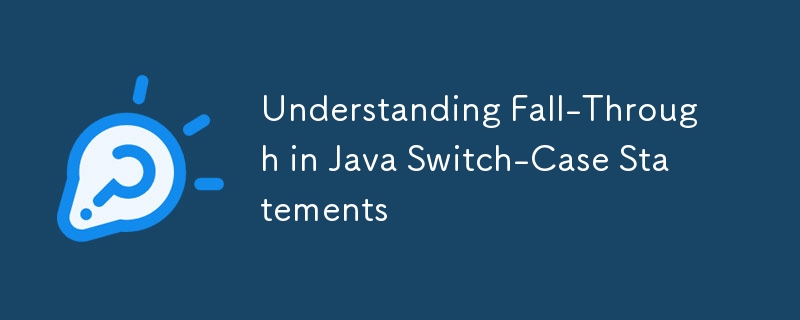

In Java programming, the switch-case statement is a control structure used to execute one block of code among many based on the value of a variable. It can be more efficient and readable than using multiple if-else statements. One important concept to understand when working with switch-case statements is "fall-through."
Fall-through occurs when the code execution continues from one case to the next without encountering a break statement. By default, after a matching case block is executed, the control flow will fall through to the subsequent case blocks until a break statement is encountered or the switch statement ends.
Here is the basic syntax of a switch-case statement in Java:
switch (expression) {
case value1:
// code block
break;
case value2:
// code block
break;
default:
// default code block
}
Let's look at an example to understand how fall-through works:
int day = 2;
switch (day) {
case 1:
System.out.println("Monday");
case 2:
System.out.println("Tuesday");
case 3:
System.out.println("Wednesday");
default:
System.out.println("Other day");
}
In this example, the output will be:
Tuesday Wednesday Other day
When day is equal to 2, the case 2 block is executed, printing "Tuesday." Since there is no break statement after case 2, the execution continues to case 3 and then to the default case, printing "Wednesday" and "Other day" respectively. This is a classic example of fall-through behavior.
To prevent fall-through, you should end each case with a break statement:
int day = 2;
switch (day) {
case 1:
System.out.println("Monday");
break;
case 2:
System.out.println("Tuesday");
break;
case 3:
System.out.println("Wednesday");
break;
default:
System.out.println("Other day");
break;
}
Now, the output will be:
Tuesday
Sometimes, fall-through can be used intentionally to execute multiple cases with the same block of code:
int day = 2;
switch (day) {
case 1:
case 2:
case 3:
case 4:
case 5:
System.out.println("It's a weekday");
break;
case 6:
case 7:
System.out.println("It's a weekend");
break;
default:
System.out.println("Invalid day");
}
In this example, day values 1 through 5 will all result in "It's a weekday" being printed.
Understanding fall-through in switch-case statements is crucial for writing clear and bug-free Java code. While fall-through can be useful in certain scenarios, it is generally a good practice to use break statements to prevent unintended behavior.
Note: Unlike Java, the case-when construct in Ruby does not exhibit fall-through behavior. Each when clause is independent, and execution does not automatically continue to subsequent when clauses without explicit instructions.
Das obige ist der detaillierte Inhalt vonGrundlegendes zum Fall-Through in Java-Switch-Case-Anweisungen. Für weitere Informationen folgen Sie bitte anderen verwandten Artikeln auf der PHP chinesischen Website!
 Einführung in Screenshot-Tastenkombinationen in Win10
Einführung in Screenshot-Tastenkombinationen in Win10
 So öffnen Sie eine RAR-Datei
So öffnen Sie eine RAR-Datei
 Vorteile des Herunterladens der offiziellen Website der Yiou Exchange App
Vorteile des Herunterladens der offiziellen Website der Yiou Exchange App
 Es ist nicht möglich, das Standard-Gateway des Computers zu reparieren
Es ist nicht möglich, das Standard-Gateway des Computers zu reparieren
 So geben Sie doppelte Anführungszeichen in Latex ein
So geben Sie doppelte Anführungszeichen in Latex ein
 Tim Mobile online
Tim Mobile online
 Einführung in den Unterschied zwischen Javascript und Java
Einführung in den Unterschied zwischen Javascript und Java
 MySQL-Datenbank wiederherstellen
MySQL-Datenbank wiederherstellen




